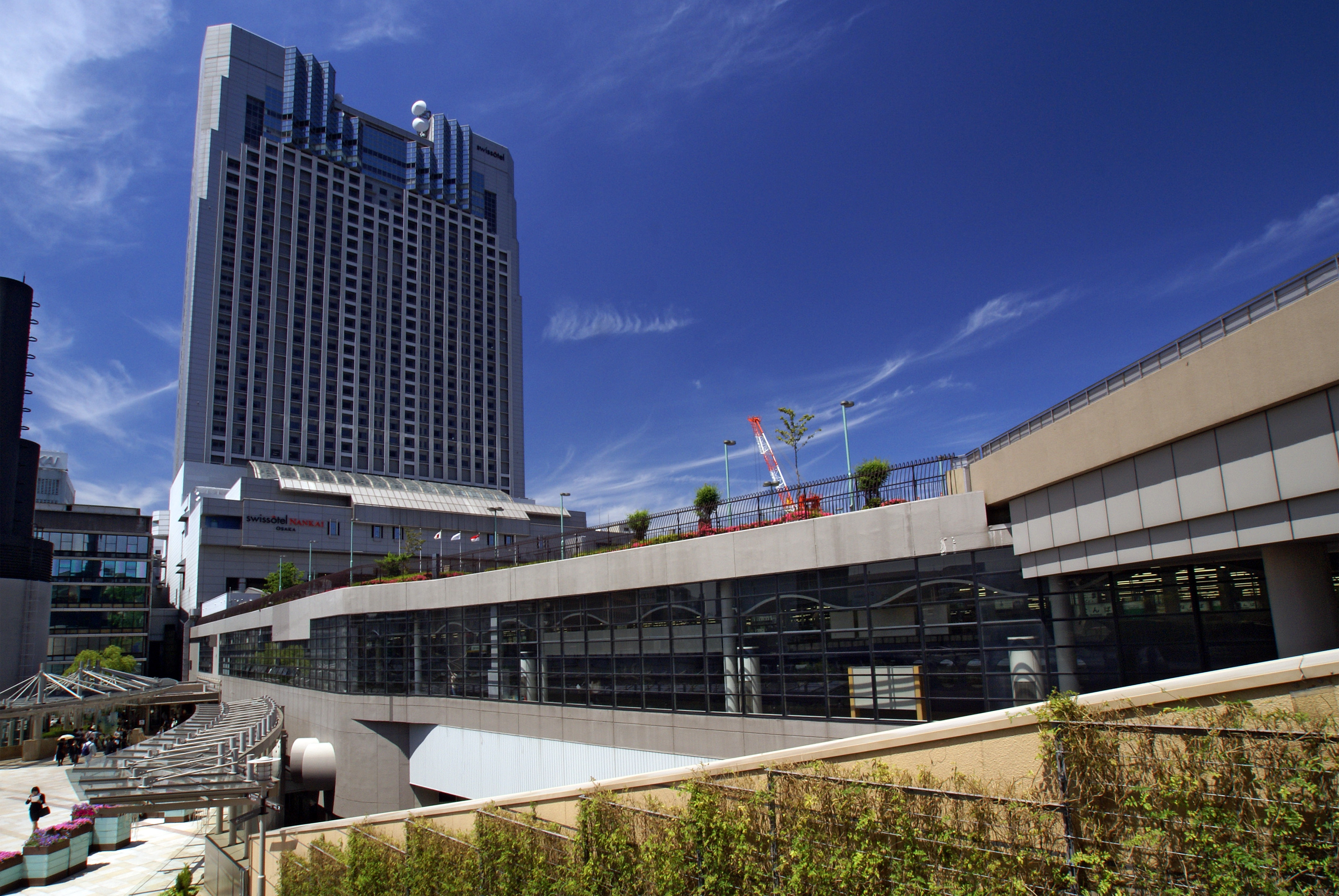|
Mozuhachiman Station
is a passenger railway station located in Sakai-ku, Sakai, Osaka Prefecture, Japan, operated by the private railway operator Nankai Electric Railway. It has the station number "NK58". Lines Mozuhachiman Station is served by the Nankai Kōya Line, and is 13.4 kilometers from the terminus of the line at and 12.7 kilometers from . Layout The station consists of two opposed side platforms connected by a footbridge. Platforms Adjacent stations History Mozuhachiman Station opened on September 7, 1900. Passenger statistics In fiscal 2019, the station was used by an average of 4,545 passengers daily. Surrounding area *Mozuhachiman-gu *Sakai City Sakai High School *Seikeikai Medical College See also * List of railway stations in Japan The links below contain all of the 8579 railway stations in Japan. External links {{Portal bar, Japan, Trains * Railway stations A train station, railway station, railroad station or depot is a railway facility where ... [...More Info...] [...Related Items...] OR: [Wikipedia] [Google] [Baidu] |
Nankai Group Logo
Nankai () is a family of schools in China founded by Yan Xiu (严范孙) (1860–1920) and Zhang Boling (张伯苓) (1876–1951). The schools include: * Nankai High School in Tianjin (天津南开中学) (1904). * Nankai University in Tianjin (南开大学) (1919). * The Nankai Women's High School (1923), Tianjin Second Nankai High School (天津第二南开中学) (present). * The Nankai Elementary School in Tianjin (天津南开小学) (1928, ruined in WW2). * Nanyu High School (1935), Chongqing Nankai Secondary School (重庆南开中学) (1936). * Chongqing Nankai Elementary School (重庆南开小学) (1937). * Shuguang Middle School in Zigong (自贡蜀光中学) (1937). * Nankai University Affiliated High School (南开大学附中) (1954). Nankai District (南开区, Nán-kāi Qū) in the city of Tianjin Tianjin (; ; Mandarin: ), alternately romanized as Tientsin (), is a municipality and a coastal metropolis in Northern China on the shore of the Bohai Sea. I ... [...More Info...] [...Related Items...] OR: [Wikipedia] [Google] [Baidu] |
Nankai Electric Railway
is a private railway in Japan, founded in 1884. The name ''Nankai'' (which means "South Sea") comes from the company's routes along the Nankaidō, the old highway that ran south from the old capital, Kyoto, along the sea coast. Nankai predates all the electric railways in the Tokyo region. The Nankai network branches out in a generally southern direction from Namba Station in Osaka. The Nankai Main Line connects Osaka to Wakayama, with an important spur branching to Kansai International Airport. The '' rapi:t α'' express connects Kansai International Airport to Namba in 34 minutes, while the '' rapi:t β'' takes 39 minutes with two additional stops. The Koya Line connects Osaka to Mt. Koya, headquarters of the Buddhist Shingon sect and a popular pilgrimage site. IC cards (PiTaPa and ICOCA) are accepted. History The Nankai Railway Company was founded on June 16, 1884. In 1944 it was one of the companies that merged to form Kinki Nippon Railway Co., Ltd. (Kin-nichi, prese ... [...More Info...] [...Related Items...] OR: [Wikipedia] [Google] [Baidu] |
Nankai Koya Line Symbol
Nankai () is a family of schools in China founded by Yan Xiu (严范孙) (1860–1920) and Zhang Boling (张伯苓) (1876–1951). The schools include: * Nankai High School in Tianjin (天津南开中学) (1904). * Nankai University in Tianjin (南开大学) (1919). * The Nankai Women's High School (1923), Tianjin Second Nankai High School (天津第二南开中学) (present). * The Nankai Elementary School in Tianjin (天津南开小学) (1928, ruined in WW2). * Nanyu High School (1935), Chongqing Nankai Secondary School (重庆南开中学) (1936). * Chongqing Nankai Elementary School (重庆南开小学) (1937). * Shuguang Middle School in Zigong (自贡蜀光中学) (1937). * Nankai University Affiliated High School (南开大学附中) (1954). Nankai District (南开区, Nán-kāi Qū) in the city of Tianjin Tianjin (; ; Mandarin: ), alternately romanized as Tientsin (), is a municipality and a coastal metropolis in Northern China on the shore of the Bohai Sea. I ... [...More Info...] [...Related Items...] OR: [Wikipedia] [Google] [Baidu] |
Koya Line
The is a railway line in Osaka Prefecture and Wakayama Prefecture, Japan, owned and operated by the Nankai Electric Railway, a private railway operator. It connects Osaka and Koyasan, the capital of the Japanese Buddhist sect Shingon, via the suburbs of Osaka, such as Sakai, Osakasayama, Tondabayashi and Kawachinagano in Osaka Prefecture and Hashimoto and Kōya in Wakayama Prefecture. To distinguish it from other Nankai Lines, the Kōya Line is indicated with pictograms of coniferous-like trees which bring to mind Mount Kōya, or with the line colour, green. For historical reasons, the line formally begins at Shiomibashi Station in Osaka and crosses the Nankai Main Line, the company's other main line, at Kishinosato-Tamade Station, though operationally it starts at Namba Station together with the Nankai Line, diverges at Kishinosato-Tamade Station and goes to Gokurakubashi Station, to connect to Koyasan through Nankai Cable Line. The section from Shiomibashi to Kishinosato- ... [...More Info...] [...Related Items...] OR: [Wikipedia] [Google] [Baidu] |
Railway Station
Rail transport (also known as train transport) is a means of transport that transfers passengers and goods on wheeled vehicles running on rails, which are incorporated in tracks. In contrast to road transport, where the vehicles run on a prepared flat surface, rail vehicles (rolling stock) are directionally guided by the tracks on which they run. Tracks usually consist of steel rails, installed on sleepers (ties) set in ballast, on which the rolling stock, usually fitted with metal wheels, moves. Other variations are also possible, such as "slab track", in which the rails are fastened to a concrete foundation resting on a prepared subsurface. Rolling stock in a rail transport system generally encounters lower frictional resistance than rubber-tyred road vehicles, so passenger and freight cars (carriages and wagons) can be coupled into longer trains. The operation is carried out by a railway company, providing transport between train stations or freight customer facilit ... [...More Info...] [...Related Items...] OR: [Wikipedia] [Google] [Baidu] |
Sakai-ku, Sakai
is a ward of the city of Sakai in Osaka Prefecture, Japan. The ward has an area of 23.69 km² and a population of 147,413. The population density is 6,223 per square kilometer. (Ward office official home page) (Retrieved on February 27, 2010) The wards of Sakai were established when Sakai became a on April 1, 2006. The city has its municipal headquarters in Sakai-ku and is located in the area. Train stations lo ...
|
Sakai, Osaka
is a city located in Osaka Prefecture, Japan. It has been one of the largest and most important seaports of Japan since the medieval era. Sakai is known for its keyhole-shaped burial mounds, or kofun, which date from the fifth century and include Daisen Kofun, the largest grave in the world by area. Once known for swords, Sakai is now famous for the quality of its cutlery. , the city had an estimated population of 819,965, making it the fourteenth most populous city in Japan (excluding Tokyo). Geography Sakai is located in southern Osaka Prefecture, on the edge of Osaka Bay and directly south of the city of Osaka. Neighboring municipalities Osaka Prefecture *Osaka * Matsubara *Habikino *Ōsakasayama *Kawachinagano * Izumi * Takaishi Climate Sakai has a Humid subtropical climate (Köppen ''Cfa'') characterized by warm summers and cool winters with light to no snowfall. The average annual temperature in Sakai is . The average annual rainfall is with June as the wettest month ... [...More Info...] [...Related Items...] OR: [Wikipedia] [Google] [Baidu] |
Osaka Prefecture
is a Prefectures of Japan, prefecture of Japan located in the Kansai region of Honshu. Osaka Prefecture has a population of 8,778,035 () and has a geographic area of . Osaka Prefecture borders Hyōgo Prefecture to the northwest, Kyoto Prefecture to the north, Nara Prefecture to the southeast, and Wakayama Prefecture to the south. Osaka is the capital and largest city of Osaka Prefecture, and the List of cities in Japan, third-largest city in Japan, with other major cities including Sakai, Higashiōsaka, and Hirakata. Osaka Prefecture is the third-most-populous prefecture, but by geographic area the second-smallest; at it is the second-most densely populated, below only Tokyo. Osaka Prefecture is one of Japan's two "Fu (country subdivision), urban prefectures" using the designation ''fu'' (府) rather than the standard ''Prefectures of Japan#Types of prefecture, ken'' for prefectures, along with Kyoto Prefecture. Osaka Prefecture forms the center of the Keihanshin metropolitan ar ... [...More Info...] [...Related Items...] OR: [Wikipedia] [Google] [Baidu] |
Nankai Kōya Line
The is a railway line in Osaka Prefecture and Wakayama Prefecture, Japan, owned and operated by the Nankai Electric Railway, a private railway operator. It connects Osaka and Koyasan, the capital of the Japanese Buddhist sect Shingon, via the suburbs of Osaka, such as Sakai, Osakasayama, Tondabayashi and Kawachinagano in Osaka Prefecture and Hashimoto and Kōya in Wakayama Prefecture. To distinguish it from other Nankai Lines, the Kōya Line is indicated with pictograms of coniferous-like trees which bring to mind Mount Kōya, or with the line colour, green. For historical reasons, the line formally begins at Shiomibashi Station in Osaka and crosses the Nankai Main Line, the company's other main line, at Kishinosato-Tamade Station, though operationally it starts at Namba Station together with the Nankai Line, diverges at Kishinosato-Tamade Station and goes to Gokurakubashi Station, to connect to Koyasan through Nankai Cable Line. The section from Shiomibashi to Kishinosato ... [...More Info...] [...Related Items...] OR: [Wikipedia] [Google] [Baidu] |
Terminal Station
A train station, railway station, railroad station or depot is a railway facility where trains stop to load or unload passengers, freight or both. It generally consists of at least one platform, one track and a station building providing such ancillary services as ticket sales, waiting rooms and baggage/freight service. If a station is on a single-track line, it often has a passing loop to facilitate traffic movements. Places at which passengers only occasionally board or leave a train, sometimes consisting of a short platform and a waiting shed but sometimes indicated by no more than a sign, are variously referred to as "stops", "flag stops", " halts", or "provisional stopping places". The stations themselves may be at ground level, underground or elevated. Connections may be available to intersecting rail lines or other transport modes such as buses, trams or other rapid transit systems. Terminology In British English, traditional terminology favours ''railway station'' ... [...More Info...] [...Related Items...] OR: [Wikipedia] [Google] [Baidu] |
Side Platform
A side platform (also known as a marginal platform or a single-face platform) is a platform positioned to the side of one or more railway tracks or guideways at a railway station, tram stop, or transitway. A station having dual side platforms, one for each direction of travel, is the basic design used for double-track railway lines (as opposed to, for instance, the island platform where a single platform lies between the tracks). Side platforms may result in a wider overall footprint for the station compared with an island platform where a single width of platform can be shared by riders using either track. In some stations, the two side platforms are connected by a footbridge running above and over the tracks. While a pair of side platforms is often provided on a dual-track line, a single side platform is usually sufficient for a single-track line. Layout Where the station is close to a level crossing (grade crossing) the platforms may either be on the same side of the cross ... [...More Info...] [...Related Items...] OR: [Wikipedia] [Google] [Baidu] |
List Of Railway Stations In Japan ...
The links below contain all of the 8579 railway stations in Japan. External links {{Portal bar, Japan, Trains * Railway stations Japan Japan ( ja, 日本, or , and formally , ''Nihonkoku'') is an island country in East Asia. It is situated in the northwest Pacific Ocean, and is bordered on the west by the Sea of Japan, while extending from the Sea of Okhotsk in the north ... [...More Info...] [...Related Items...] OR: [Wikipedia] [Google] [Baidu] |




.jpg)